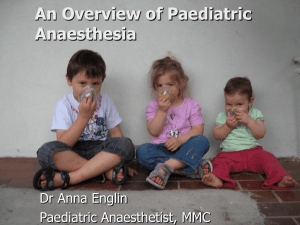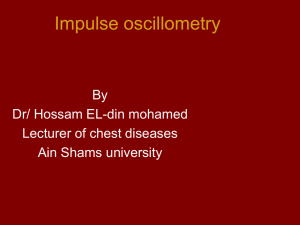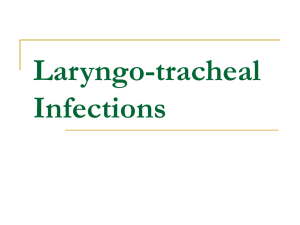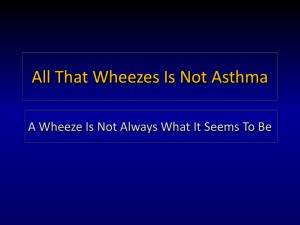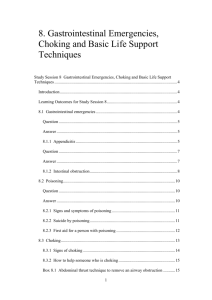brachycephalic_airway_syndrome
advertisement
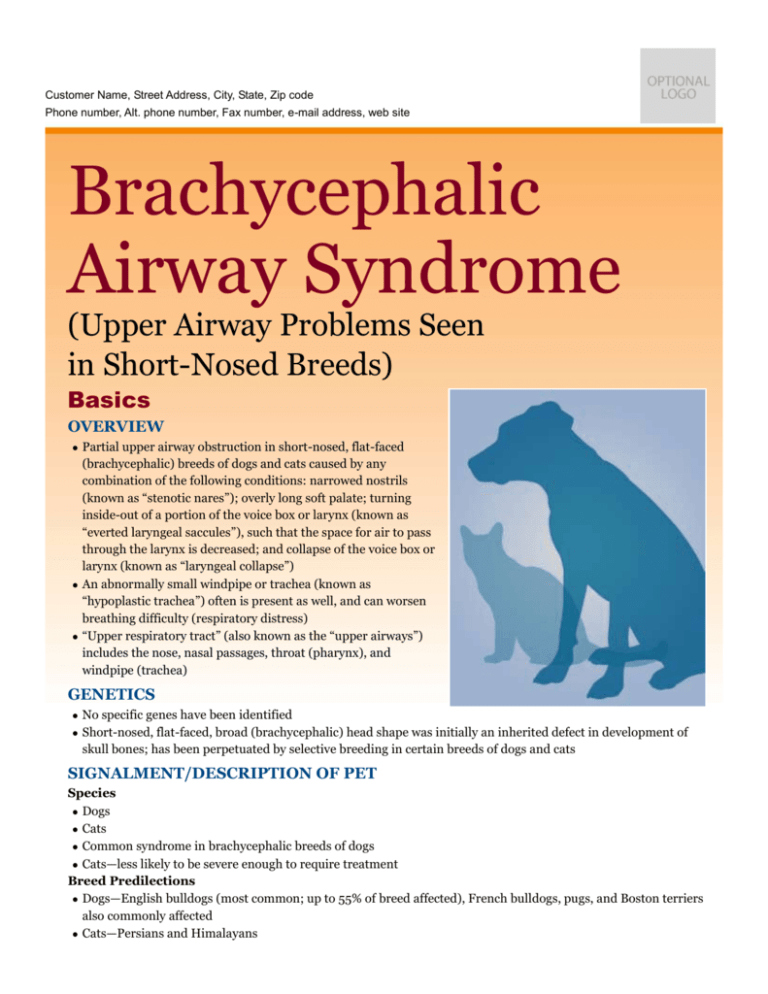
Customer Name, Street Address, City, State, Zip code Phone number, Alt. phone number, Fax number, e-mail address, web site Brachycephalic Airway Syndrome (Upper Airway Problems Seen in Short-Nosed Breeds) Basics OVERVIEW Partial upper airway obstruction in short-nosed, flat-faced (brachycephalic) breeds of dogs and cats caused by any combination of the following conditions: narrowed nostrils (known as “stenotic nares”); overly long soft palate; turning inside-out of a portion of the voice box or larynx (known as “everted laryngeal saccules”), such that the space for air to pass through the larynx is decreased; and collapse of the voice box or larynx (known as “laryngeal collapse”) An abnormally small windpipe or trachea (known as “hypoplastic trachea”) often is present as well, and can worsen breathing difficulty (respiratory distress) “Upper respiratory tract” (also known as the “upper airways”) includes the nose, nasal passages, throat (pharynx), and windpipe (trachea) GENETICS No specific genes have been identified Short-nosed, flat-faced, broad (brachycephalic) head shape was initially an inherited defect in development of skull bones; has been perpetuated by selective breeding in certain breeds of dogs and cats SIGNALMENT/DESCRIPTION OF PET Species Dogs Cats Common syndrome in brachycephalic breeds of dogs Cats—less likely to be severe enough to require treatment Breed Predilections Dogs—English bulldogs (most common; up to 55% of breed affected), French bulldogs, pugs, and Boston terriers also commonly affected Cats—Persians and Himalayans Mean Age and Range Young adults, most diagnosed by 2–3 years of age If diagnosed later than 4 years of age, another disease or condition may be adding to upper airway obstruction leading to diagnosis; older dogs may have a worse outcome post-operatively, but most have some improvement Collapse of the voice box or larynx (known as “laryngeal collapse”) reported in short-nosed, flat faced (brachycephalic) breed puppies as young as 6–7 months of age SIGNS/OBSERVED CHANGES IN THE PET Snoring; high-pitched, noisy breathing (stridor); noisy breathing when inhaling (stertorous breathing) Rapid breathing (known as “tachypnea”), frequent panting Coughing and gagging Difficulty eating and swallowing Excessive salivation (known as “ptyalism”), regurgitation (return of food or other contents from the esophagus or stomach back up through the mouth), and vomiting Occasionally, fainting (syncope) and episodes of collapse Narrowed nostrils (stenotic nares) Increased breathing (respiratory) effort—may see pulling back of the lips with each breath, open-mouth breathing or constant panting, increased breathing rate, turning of the elbows away from the body (abduction of forelimbs) in an effort to open up the chest, increased abdominal effort during breathing In severe breathing distress, may have increased difficulty in breathing while lying flat (known as “orthopnea”), even to point of reluctance to lie down; and bluish discoloration of skin and moist tissues of body (known as “cyanosis”) Increased body temperature (known as “hyperthermia”) may be present CAUSES Brachycephalic airway syndrome results from inherited defects or developmental/growth defects of the upper airway. These defects include the following: Elongated soft palate—reported in over 90% of surgical cases in dogs Narrowed nostrils (stenotic nares)—reported in about 50% of cases in dogs; most common defect in cats Voice box or laryngeal disease—everted laryngeal saccules (over 50% of affected dogs) and/or laryngeal collapse (approximately 10% of affected dogs) Abnormally small windpipe (hypoplastic trachea); primarily in the English bulldog RISK FACTORS Brachycephalic breed Obesity—worsens airway obstruction; associated with poorer outcome following surgical correction; may contribute to backward or reverse flow of stomach contents into the esophagus (known as “gastroesophageal reflux”) and development of aspiration pneumonia Excitement and/or warm, humid weather—increased panting can lead to fluid buildup (edema) in the tissues of the airway, further narrowing the airway opening, and leading to increased body temperature (hyperthermia) Exercise—dogs often are unable to exercise because of airway compromise and low levels of oxygen in their blood (hypoxia) Sedation may cause relaxation of the muscles of throat (pharynx) and soft palate, and may cause complete airway obstruction Lung disease (such as pneumonia, pulmonary edema)—will cause additional breathing compromise Endocrine disease (such as low levels of thyroid [known as “hypothyroidism”] or high levels of steroids [known as “hyperadrenocorticism” or “Cushing's syndrome”])—could worsen weight gain and cause excessive panting Treatment HEALTH CARE Surgery recommended for pets with significant clinical signs Emergency presentation with pet in severe breathing distress requires rapid medical intervention, including oxygen supplementation If the pet has high body temperature (hyperthermia), cool with iced water and by directing a fan to blow over the pet (increase convective heat loss); intravenous (IV) fluids should be administered, up to a shock rate if has an extremely elevated body temperature (greater than 106°F) If the airway is completely obstructed, the airway must be opened; this may be accomplished by passing an endotracheal tube through the mouth and into the windpipe (known as “orotracheal intubation”) and/or by a surgical incision into the windpipe (known as a “temporary tracheostomy”) Dexamethasone can be administered to reduce inflammation Pets need 24-hour monitoring because of risk of acute airway obstruction and death Breathing rate and effort, heart rate, pulse quality, color of gums and moist tissues (mucous membrane color), time for pink color to return to gums after blanching them with one's finger (capillary refill time), temperature, and other physical parameters should be monitored Pulse oximetry and arterial blood gases to determine oxygen levels in the blood may be monitored, depending on severity of condition Intravenous fluids are administered at maintenance rate and handling and stress are minimized ACTIVITY Usually self-limited by the pet DIET Weight loss is recommended for all overweight dogs and cats For obese, stable pets, weight loss is recommended prior to surgery SURGERY Evaluation for elongated soft palate generally is performed under general anesthesia when the pet is stable Surgical incision into the windpipe (temporary tracheostomy) can be performed to facilitate exposure or to treat airway obstruction Narrowed nostrils (stenotic nares) are corrected by surgically removing a wedge of the nasal tissue and closing the incision in such a manner to allow the nostril to be enlarged Elongated soft palate is treated by surgically removing a section of the soft palate using surgical scissors, carbon dioxide laser, or a bipolar sealing device Everted laryngeal saccules are treated by surgically trimming the tissue Permanent surgical opening into the windpipe or trachea (known as a “permanent tracheotomy”) may be necessary if severe laryngeal collapse is present Medications Medications presented in this section are intended to provide general information about possible treatment. The treatment for a particular condition may evolve as medical advances are made; therefore, the medications should not be considered as all inclusive Dexamethasone to reduce fluid buildup (edema) and inflammation Broad-spectrum antibiotics are indicated if aspiration pneumonia is present, until culture and sensitivity results are obtained Omeprazole, cisapride, and magnesium hydroxide after meals or sucralfate resulted in improvement in dogs that also have inflammation of the esophagus (known as “esophagitis”), inflammation of the stomach (known as “gastritis”) and/or inflammation of the upper small intestine (known as the “duodenum”; condition known as “duodenitis”) Follow-Up Care PATIENT MONITORING Post-operatively, 24-hour monitoring to observe for airway swelling and obstruction, which may require surgical incision into the windpipe (temporary tracheostomy) Breathing rate, effort, heart rate, pulse quality, mucous membrane color, capillary refill time, temperature, and other physical parameters should be monitored PREVENTIONS AND AVOIDANCE Selection by breeders for dogs without severe conformational changes—may be difficult because breed standards encourage these structural changes Avoid risk factors, particularly weight gain POSSIBLE COMPLICATIONS Overheating and heat stroke Aspiration pneumonia (inflammation of the lungs, caused by accidentally inhaling food, vomit, or liquids into the airways) Death in about 10% of affected pets as a result of airway disease Most common post-operative complication is airway swelling and obstruction within the first 24 hours, may necessitate surgical incision into the windpipe (temporary tracheostomy) Continued breathing difficulty after corrective surgery Excessive shortening of the soft palate resulting in aspiration of food contents into the nasal cavity due to inability to close off the area between the nose and throat (known as the “nasopharynx”) during swallowing EXPECTED COURSE AND PROGNOSIS Prognosis is good for improvement in breathing (80% of cases have good to excellent results following surgery) but airway is still far from normal Prognosis better for dogs other than English bulldogs and for dogs that have correction of narrowed nostrils (stenotic nares) and elongated soft palate during same surgery Without surgery, prognosis is poor due to continued progression of brachycephalic airway syndrome Lifelong avoidance of risk factors recommended to decrease chance of developing clinical signs or worsening of disease Key Points Avoidance of risk factors is critical Dogs with brachycephalic airway syndrome are at increased anesthetic risk, and an even higher risk occurs if they also have obesity, heart disease, or aspiration pneumonia (inflammation of the lungs, caused by accidentally inhaling food, vomit, or liquids into the airways) Surgery often improves the clinical signs but does not result in a completely normal airway Enter notes here Blackwell's Five-Minute Veterinary Consult: Canine and Feline, Fifth Edition, Larry P. Tilley and Francis W.K. Smith, Jr. © 2011 John Wiley & Sons, Inc.


